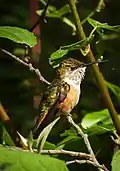| Selasphorus | |
|---|---|
 | |
| Female broad-tailed hummingbird (Selasphorus platycercus) at nest | |
| Scientific classification | |
| Domain: | Eukaryota |
| Kingdom: | Animalia |
| Phylum: | Chordata |
| Class: | Aves |
| Clade: | Strisores |
| Order: | Apodiformes |
| Family: | Trochilidae |
| Subfamily: | Trochilinae |
| Tribe: | Mellisugini |
| Genus: | Selasphorus Swainson, 1832 |
| Type species | |
| Trochilus rufus Gmelin, 1788 | |
| Species | |
|
See text | |
| Synonyms[1] | |
| |
Selasphorus is a genus of hummingbirds from Middle and North America.
Taxonomy
The genus Selasphorus was introduced in 1832 by the English naturalist William John Swainson to accommodate the rufous hummingbird which is now the type species.[2][3] The name combines the Ancient Greek selas meaning "light" or "flame" with -phoros meaning "-carrying".[4]
The genus contains the following nine species:[5]
| Image | Name | Common name | Distribution |
|---|---|---|---|
 |
Selasphorus ardens | Glow-throated hummingbird | western Panama |
 |
Selasphorus calliope | Calliope hummingbird | California to British Columbia, and migrates to the Southwestern United States, Mexico |
.jpg.webp) |
Selasphorus ellioti | Wine-throated hummingbird | El Salvador, Guatemala, Honduras, and Mexico. |
.jpg.webp) |
Selasphorus flammula | Volcano hummingbird | Costa Rica and western Panama. |
 |
Selasphorus heloisa | Bumblebee hummingbird | Mexico |
.jpg.webp) |
Selasphorus platycercus | Broad-tailed hummingbird | western United States and Western Canada to Mexico and Guatemala. |
.jpg.webp) |
Selasphorus rufus | Rufous hummingbird | western United States and Mexican state of Guerrero |
.jpg.webp) |
Selasphorus sasin | Allen's hummingbird | coastal California from Santa Barbara north, southern coastal Oregon, and southern central Mexico. |
.jpg.webp) |
Selasphorus scintilla | Scintillant hummingbird | Costa Rica and Panama |
The wine-throated hummingbird and the bumblebee hummingbird were formerly placed in the genus Atthis. Molecular phylogenetic studies published in 2014 and 2017 found that Atthis was embedded within Selasphorus. The genera were therefore merged and these hummingbirds were moved to Selasphorus.[5][6][7]
References
- ↑ "Selasphorus Swainson, 1832". Integrated Taxonomic Information System. Retrieved 6 July 2022.
- ↑ Swainson, William John; Richardson, J. (1831). Fauna boreali-americana, or, The zoology of the northern parts of British America. Vol. Part 2. The Birds. London: J. Murray. p. 324. The title page bears the year 1831 but the volume did not appear until 1832.
- ↑ Peters, James Lee, ed. (1945). Check-List of Birds of the World. Vol. 5. Cambridge, Massachusetts: Harvard University Press. p. 141.
- ↑ Jobling, James A. (2010). The Helm Dictionary of Scientific Bird Names. London: Christopher Helm. p. 352. ISBN 978-1-4081-2501-4.
- 1 2 Gill, Frank; Donsker, David & Rasmussen, Pamela, eds. (July 2020). "Hummingbirds". IOC World Bird List Version 10.2. International Ornithologists' Union. Retrieved 11 January 2020.
- ↑ McGuire, J.; Witt, C.; Remsen, J.V.; Corl, A.; Rabosky, D.; Altshuler, D. & Dudley, R. (2014). "Molecular phylogenetics and the diversification of hummingbirds". Current Biology. 24 (8): 910–916. doi:10.1016/j.cub.2014.03.016. PMID 24704078.
- ↑ Licona-Vera, Yuyini & Ornelas, Juan Francisco (2017). "The conquering of North America: dated phylogenetic and biogeographic inference of migratory behavior in bee hummingbirds". BMC Evolutionary Biology. 17 (1): 126. doi:10.1186/s12862-017-0980-5. PMC 5460336. PMID 28583078.
External links
 Media related to Selasphorus at Wikimedia Commons
Media related to Selasphorus at Wikimedia Commons
This article is issued from Wikipedia. The text is licensed under Creative Commons - Attribution - Sharealike. Additional terms may apply for the media files.